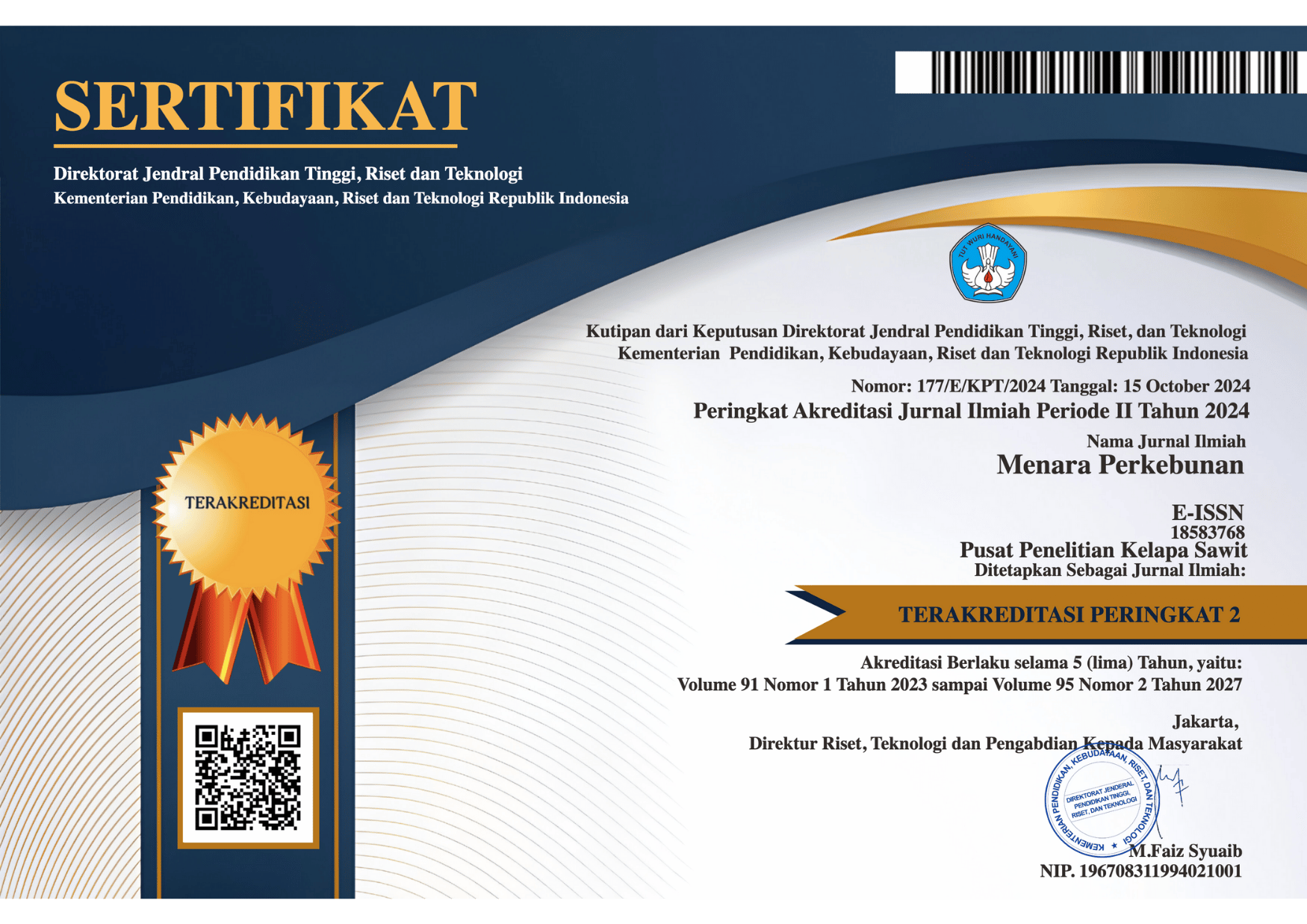Effect of Tithonia diversifolia extract on the biodegradability of the bioplastics in plantation soil (Pengaruh ekstrak Tithonia diversifolia terhadap biodegradabilitas bioplastik di tanah perkebunan)
DOI:
https://doi.org/10.22302/iribb.jur.mp.v86i2.293Keywords:
Tithonia diversifolia, biodegradibily, bioplastic, plantation soilAbstract
Effect of Tithonia diversifoliaextract on biodegradability of the bioplastic was evaluated using plantation soil as natural inoculum. The bioplastic was a composite of cellulose from cacao pod husk, starch and enriched by tithoniaextract. Biodegradation test wasereconducted in the glass jar for 60 days. The carbon dioxide generated from the biodegradation test titrated by 0.1 N sodium hydroxide solutions. The carbon dioxide was measured with 0.1 N HCl and using phenolphthalein followed by methyl orange as indicator. Carbon dioxide was detected in the bioplastic samples but not detected in the conventional plastic sample during the test. Biodegradation of the bioplastic enriched by tithoniaextract was higher than that of the bioplastic without tithoniaextract. Biodegra-dation rate of the bioplastic samples in plantation soil were 0.068 mg CO2/day and 0.178 mg CO2/day for the bioplastic without and with tithoniaextract, respectively. Biodegradation of the bioplastic samples for 45 days were 12.44% and 28.07% for the bioplastic without and with tithoniaextract, respectively. Complete biodegradation of the bioplastic predicted in 244 days and 200 days for the bioplastic without and with tithoniaextract, respectively.
[Kata kunci :Tithonia diversifolia, biodegrada-bility, bioplastic, plantation soil].
Abstrak
Pengaruh ekstrak Tithonia diversifoliaterhadap biodegradabilitas bioplastik dievaluasi dengan menggunakan tanah perkebunan sebagai inokulum alami. Bioplastik yang digunakan adalah komposit selulosa dari kulit buah kakao, pati dan diperkaya dengan ekstrak tithonia. Uji biodegra-dasi dilakukan di dalam botol selama 60 hari. Karbon dioksida yang dihasilkan dari uji biodegradasi diserap oleh larutan natrium hidroksida 0,1 N. Karbon dioksida dititrasi dengan HCl 0,1 N dan menggunakan fenolftalein diikuti dengan metil jingga sebagai indikator. Karbon dioksida terdeteksi pada sampel bioplastik namun tidak terdeteksi pada sampel plastik konvensional.Bioplastik yang diperkaya dengan ekstrak tithonia menghasilkan tingkat biodegradasi yang lebih tinggi dari pada bioplastik tanpa ekstrak tithonia. Tingkat biodegradasi sampel bioplastik di tanah perkebunan adalah 0,068 mg CO2/hari dan0,188 mg CO2/hari masing-masing untuk bioplastik tanpa dan dengan ekstrak tithonia. Biodegradasi sampel bioplastik selama 45 hari adalah 12,44% dan 28,07%berturut-turutuntuk bioplastik tanpa dan dengan ekstrak tithonia. Biodegradasi keseluruhan bioplastik diperkirakan membutuh-kan waktu 244 hari dan 200 harimasing-masinguntuk bioplastik tanpa dan dengan ekstrak tithonia.
[Keywords:Tithonia diversifolia, biodegradaibi-litas, bioplastik, tanah perkebunan].
Downloads
References
Adhikari, D., Mukai, M., Kubota, K., Kai, T., Kaneko, N., Araki, K. S., & Kubo, M. (2016). Degradation of bioplastics in soil and their degradation effects on environmental microorganisms. Journal of Agricultural Chemistry and Environment, 5(1), 23.
Afrizon, & Rosmana, S. (2002). Efektivitas Komponen Pengendalian Hama Penggerek Buah Kakao ( PBK) Terhadap Tingkat Serangan PBK di Kabupaten Kepahiang. Jurnal Litbang Pertanian, 21(2), 69–74.
Daud, Z., Kassim, M., Sari, A., Mohd Aripin, A., Awang, H., Hatta, M., & Zainuri, M. (2013). Chemical composition and morphological of cocoa pod husks and cassava peels for pulp and paper production. Australian Journal of Basic and Applied Sciences, 7(9), 406–411.
Depparaba, F. (2002). Penggerek buah kakao (Conopomorpha cramerella Snellen) dan penanggulangannya. Jurnal Litbang Pertanian, 21(2), 69–74.
Dirjenbun. (2016). Statistik Perkebunan Indonesia: Kakao 2014-2016. Jakarta.
Hutomo, G. S., Marseno, D. W., Anggrahini, S., & others. (2012). Synthesis and characterization of sodium carboxymethylcellulose from pod husk of Cacao (Theobroma cacao L.). African Journal of Food Science, 6(6), 180–185.
Isroi, Cifriadi, A., Panji, T., Wibowo, N. A., & Syamsu, K. (2017). Bioplastic production from cellulose of oil palm empty fruit bunch. IOP Conference Series: Earth and Environmental Science, 65, 12011. https://doi.org/10.1088/1755-1315/65/1/012011
Joseph, K. C., Montepio, R. C., Abenoja, R. M., & Tuyogon, R. F. (2017). Design, Development and Evaluation of a Mechanical Cacao Pod Bagger/Sleever. International Journal of Scientific & Engineering Research, 8(5), 585–589.
Khaswar, S., Setyowati, K., & Khoiri, A. A. (2008). The Effect of Plastisizer Additions (Polyethylene Glycol 400 and Dimethyl Phtalate) on the Biodegradation Process of Bioplastics Poly-b-Hydroxyalkanoat in Liquid Media with Limited Air. Jurnal Teknologi Pertanian, 4(1), 4–14.
Klemchuk, P. P. (1990). Degradable plastics: a critical review. Polymer Degradation and Stability, 27(2), 183–202.
McMahon, P., bin Purung, H., Lambert, S., Mulia, S., Susilo, A. W., Sulistyowati, E., … others. (2015). Testing local cocoa selections in three provinces in Sulawesi:(i) Productivity and resistance to cocoa pod borer and Phytophthora pod rot (black pod). Crop Protection, 70, 28–39.
Miranda, M. A. F. M., Varela, R. M., Torres, A., Molinillo, J. M. G., Gualtieri, S. C. J., & Mac’ias, F. A. (2015). Phytotoxins from Tithonia diversifolia. Journal of Natural Products, 78(5), 1083–1092.
Otusanya, O., & Ilori, O. (2012). Phytochemical screening and the phytotoxic effects of aqueous extracts of Tithonia diversifolia (Hemsl) a. Gray. International Journal of Biology, 4(3), 97.
Rosmana, A., Shepard, M., Hebbar, P., & Mustari, A. (2013). Control of cocoa pod borer and Phytophthora pod rot using degradable plastic pod sleeves and a nematode, Steinernema carpocapsae. Indonesian Journal of Agricultural Science, 11(2), 41–47.
Saripah, B., Azhar, I., Board, M. C., & Floor, W. S. (2007). Implementation of cocoa pod sleeving in controlling cocoa pod borer infestation. In 2007 Conference on Plantation Commodities,, Putra World Trade Centre, Kuala Lumpur (Malaysia), 3-4 Jul 2007.
Downloads
Submitted
Accepted
Published
How to Cite
Issue
Section
License
Authors retain copyright and grant the journal right of first publication with the work simultaneously licensed under a Creative Commons Attribution License that allows others to share the work with an acknowledgement of the work's authorship and initial publication in this journal.













